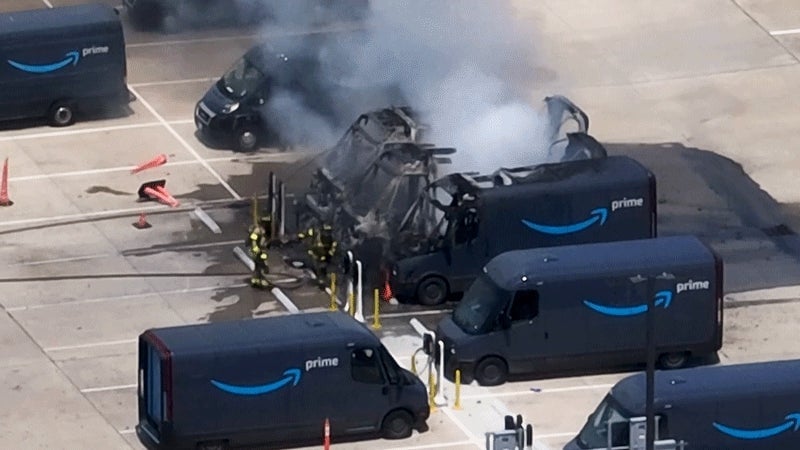Amazon's electric delivery vans keep catching on fire
Chargers have been blamed for fires before, either due to improper home wiring or inadequate cooling

EV fires, while severe, aren’t as common as some naysayers predicted when electric power first started gaining popularity. So when a pattern in EV fires starts to emerge — say, when Rivian vans keep catching fire at Amazon distribution centers — one starts to wonder why.
Suggested Reading
Video from Third Coast Drone shows Rivian vans burning outside an Amazon center in Houston. The video doesn’t capture the beginning of the blaze, but it shows firefighters doing their best to tame the flames. Crucially, though, it also shows something else: That each van was parked at a charger.
Related Content
See, this isn’t the first set of Rivians to burn down at an Amazon location. Posts in Amazon worker subreddits show a similar situation last August in Salt Lake City, where another set of vans burned in a distribution center parking lot. Drivers in the comments noted that they’ve experienced issues with the vans charging in high heat, and suspected the chargers as having caused the blaze.
Chargers have been blamed for fires before, either due to improper home wiring or inadequate cooling. What’s still unclear, however, is whether professionally-installed chargers like these Rivian units are prone to the same issues as Level 2 chargers plugged into home dryer outlets.
Heat-related EV issues are likely only going to get more common as the world heats up, but electric vehicles continue to not be a massive fire risk. The EV transition is still worth it, in hopes of mitigating some of that temperature rise — just, maybe charge in the shade until we work out some of these kinks.
Update July 3, 2024, 10:12 AM: Rivian reached out with a statement about the van fires:
Below is Rivian’s statement regarding the issue:
We are aware of the incident and are investigating the situation.
There were no injuries from this incident.
As we are gathering information, it is too soon to say what might have caused this thermal event.
A few things to point out from the initial evidence:
There were a few vehicles impacted by the incident, but the thermal event propagated from the source to surrounding vehicles.
This vehicle was plugged into the charger, but it was not charging when the incident occurred.
The HV battery was not the initiator of the incident.
What’s most interesting here is that the vans were, apparently, definitively not charging when the fires started. This means the theory that the chargers are to blame could be in question.